#fungi examples
Text
what if bugsnax have so many calories so they can transform your body cuz like they have too many calories for you to consume at once so your body has to send it elsewhere which is how the bugsnax manages to transform your body and you slowly consume all the calories in your snakified body parts and once you've consumed them all your limbs go back to normal because there are no more extra bugsnak calories that need to be stored
some poilers below cut
and you turn into bugsnax once you eat too many because there is too much bugsnak for your body to contain so the bugsnax take over your body and turns you into bugsnax
#Bugsnax#Also thinking about how bugsnax evolved#They aren't plants or animals so I assume they are fungi#They are mimics so like#I think they started out as normal mushrooms that take over your body if you eat too much#And they began to mimic the food that was eaten by the grumpuses that ate them#To be more appealing to eat to take over more bodies and so on#And with that same mimicry gene they copied bugs and other things#So they evolved to act like bugs and look/taste like food#And they can evolve into different foods pretty quick#The best example is spoilers so if you don't want some lore spoilers then stop reading the tags now#The best example is the cappuceetle which modeled itself after Alegander's coffee#Bugsnax can copy anything they eat/come into contact with idk#So potentially they could make grumpus clones#Fun#Very fun#>:)
6 notes
·
View notes
Text
i'm in a gaster drawing mood do any of you have any specific imagery you associate him with besides hands
39 notes
·
View notes
Text
Do you guys even know how much it breaks my heart that I can’t gift bouquets of mushrooms?? Do you know how much I suffer???
#down on my knee holding up the most terrifying arrangement like. hope you know I love you.#I was at a networking thing tonight and someone somehow brought up fungi#and instead of running away continued to ask me questions?? and asked to see some examples??? AND WAS ASKING ABOUT WHAT A STIPE WAS?!??#completely set me off#showing up to dinner dates with protective gloves and a face mask#’saw these and thought of you’#holds up octopus stinkhorn a stick covered in tiny blue lights shaggy ink caps and red wax caps#<3#fungi#big fan#I have mushrooms just growing on my brain#I genuinely wanna take someone on a mushroom hunt!!!#I just! want! to gift! the homies! some beautiful! shrooms!!
6 notes
·
View notes
Text
oooops i forgot
tuesday new releases for november 14:
patrick rothfuss novella the narrow road between desires (same size as slow regard of silent things)
david baldacci has new thriller the edge
mitch albom novel about the lives of three holocaust survivors little liar
new novel from michael cunningham day
a return to the time-travel cafe: before we say goodbye by toshikazu kawaguchi author of before the coffee gets cold, english translation by geoffrey trousselot
elizabeth crook's western sequel to the which way tree, the madstone
harmony new book of poetry from whitney hanson
jacquelyn mitchard's new familial drama a very inconvenient scandal
.just once new christian fiction by karen kingsbury
letters of j.r.r. tolkien edited and selected by humphrey carpenter with assistance by christopher tolkien
rush drummer geddy lee's new memoir my effin' life
johnny cash: the life in lyrics with mark stielper
the night parade: a speculative memoir by jami nakamura lin
a woman i know: female spies, double identities, and a new story of the kennedy assasination by filmmaker mary haverstick
city on mars by kelly and zach weinersmith (good non-fiction gift for those who like the martian and laughing at elon mushk)
tomlin: the soul of a football coach by john harris
entangled life: illustrated edition by martin sheldrake - new gorgeous hardcover for the mushroom and fungi fans
core of an onion another micro-history - with recipes - from michael kurlansky, author of cod and salt
new leather gifting style black cover of 48 laws of power: special powers edition
the bill gates problem the myth of the good billionaire by tim schwab
the money kings by daniel schulman
new hardcover collector editions of madeline miller's circe and anthony doerr's all the light we cannot see
also new romance collector hardcovers of archer's voice by mia sheridan and one last stop by casey mcquiston
star wars the eye of darkness a high republic novel by george mann
the marvel multiverse role-playing game core rulebook is out now
the upcycled self by tariq 'black thought' trotter
political books 😔:
network of lies about fox news by brian stelter
biography mitt romney a reckoning by mckay coppins
mike pence's advice(?) book go home for dinner
tired of winning by jonathan karl about trump and the gop
#tuesday new releases#juggling dr appointments is getting to me - there's a reason i tell them i don't want to schedule anything during 'holiday'#it's been rainy and cool here and thus work has been bonkers bc people have nothing better to do#than shopping and hanging out with a warm beverage - plus the kids will be entertained#i swear ecery time tge weather gets 'wintery' our business goes up bc people like feeling as though they're in a movie#and bustling around wearing sweaters and jackets while carrying armfuls of shopping and packages just 'feels right'#or something#but we were not staffed to be busy like december at the current time and i am so tired (and sore)#lots of literary bio/memoirs this year for some reason mcmurtry bradbury orwell now tolkien#i wonder if i could offer gifting advice just based on new stuff?#like i cannot tell you what's a 'good' book bc tastes vary so much but if you want suggestions based on someone's interests#i'd be happy to look out for new books they won't have already read#hardcovers seem to realky be getting a push this year - idk if it's to make up for printing costs going up#or if this is just the first real wave of 'back to business post-pandemic' - publishing moves sloowly most of the time y'all#i will say that if you like fungi or birds or stuff about space or unique memoirs this is a banner year#i'm recommending the hidden language of cats to everyone who has the slightest interest lol#but like if you want military memoirs they're thinner on the ground for example#anyway feel free to ask me about new stuff - i am the last person to tell you if this vs that historical romance is better#but i'm okay at pointing out new arrivals you might never have noticed on your own
0 notes
Text
data about where carbon emissions are coming from is so frustrating cause there's all kinds of huge, sprawling, just fucking vast breakdowns of What Causes The Most Carbon Emissions Out Of All Everything In The Entire World, but those are aggregations of numerous smaller but still vast aggregations of data, which are processed and polished from various aggregations of crunched numbers, which are patched and pieced together from various studies, estimates and calculations, which are sieved out of numbers crunched from various measurements, estimates and records, which have been collected, estimated or otherwise conceived through an unspeakably huge variety of methodologies with unspeakably huge variety in limitations, reliability and margins of error.
Even if some of the data was very fine-grained at the beginning, it was filtered through some very coarse number-crunching techniques for the sake of the coarse data, so the results are only as good as the wrongest thing you did in any part of this process, but the plans of action are getting thought up from the top down, which makes the whole thing a hot fucking mess.
For example. And I just made this example up. Say you want to know whether apples or potatoes have a worse impact on climate change. So you look at one of these huge ass infographic things. And it says that potatoes are bad, whereas apples are REALLY good, the BEST crop actually. So it's better to eat apples than potatoes, you think to yourself. Actually we should find a way to replace potatoes with apples! We should fund genetic engineering of apples so they have more starch and can replace potatoes. Great idea. Time to get some investors to put $5 billion towards it.
But actually. Where'd they get that conclusion about apples? Well there's this review right here of the carbon footprint of all different fruits, seems legit. Where'd that data come from? Well it's citing this study right here saying that tree-grown crops are better because they sequester carbon, and this study right here about the distance that different fruits get transported, and this study right here where different fertilization systems are compared in terms of their carbon footprint, and this study over here that sampled 300 apple, peach, and orange farmers comparing their irrigation practices and rates of tree mortality, and this study...wow, okay, seems really reliable...
...what's the first study citing? oh, okay, here's a study about mycorrhizal networks in orchards in Oregon, saying that there's a super high density of fungal mycelium in the 16 orchards that they sampled. And here's a study about leaf litter decay rates in Switzerland under different pesticide regimes, and...okay...relationship of tree spacing to below ground vs. aboveground biomass...a review of above and below-ground biomass in semi-intensively managed orchard plots...
...That one cites "Relationship between biomass and CO2 requirements...carbon immobilization in soil of various tree species...mycorrhizal fungi impact on carbon storage...
...wait a second, none of these are talking about apples, they're about boreal forests...and orange trees...and peanut farms! They're just speculating on roughly applying the non-apple data to apples. You have to go backwards...
Yes! "A review of belowground carbon storage in orchard cropping systems!" Seems like overall the studies find potentially high carbon storage in orchard environments! Walnuts...pears...oranges... intercropping walnuts and wheat... intercropping apples and wheat... wait a second, what about orchards with only apples?
Time for you to go back again...
"New method of mulching in apple orchards can lower irrigation and pesticide needs..." okay but if it's new, most farmers aren't doing it. "Orchards with high density interplanted with annual crops show way more mycorrhizal fungus activity..." "Mycorrhizal associations with trees in the genus Malus..."
...And pretty soon you've spent Five Fucking Hours investigating apples and you've got yourself in this tangled web of citations that demonstrate that some orchard crops (not necessarily apples) store a lot of long-lasting biomass in their trunks and roots really well—and some apple orchards (not necessarily typical ones) have high amounts of mycorrhizal fungi—and some techniques of mulching in orchards (not necessarily the ones apple farmers use) experience less erosion—and some apple trees (not necessarily productive agricultural apples) have really deep root systems—
—and some environments with trees, compared with some conventional agricultural fields, store more carbon and experience less erosion, but not apple orchards because that data wasn't collected in apple orchards.
And you figure out eventually that there is no direct evidence anywhere in the inputs that singles out apples as The Best Crop For Fighting Climate Change, or suggests that conventional apple farming has a much smaller carbon footprint than anything else.
The data just spit out "apples" after an unholy writhing mass of Processes that involved 1) observing some tree-grown crops and deciding it applies closely enough to all tree grown crops 2) observing some apple orchards and deciding its applicable enough to all apple orchards 3) observing some tree-including environments and deciding its close enough to all tree-including environments 4) observing some farming methods and deciding it applies closely enough to all farming methods
And any one of these steps individually would be fine and totally unavoidable, but when strung together repeatedly they distort the original data into A Puddle of Goo.
And it wouldn't be that bad even to string them together, if trees didn't vary that much, and farming didn't vary that much, and soil didn't vary that much, and mycorrhizal networks didn't vary that much, and regions that grow apples didn't vary that much, and pre-conversion-to-apple-orchard states of apple orchards didn't vary that much, and economic incentives controlling apple farming didn't vary that much, but all of these things DO vary, a Fuck Ton, and if the full range of variation were taken into account—nay, intentionally optimized—the distinction between apples and potatoes might turn out to be be MEANINGLESS GOO.
anyway big size piles of data about Farming, In General, make me so bitchy
1K notes
·
View notes
Text
Wet Beast Wednesday: cave fish
Prepare for a deep dive today. Not because I'm going to be more in-depth than usual, but because we're talking about caves. Which are deep. In the ground.... Yeah, you get it. Today is going to be a bit different from my normal WBW posts. Instead of going in depth on a particular species or group of related species I'm going to discuss common adaptations fish evolve to live permanently in caves and then go over a few species I find interesting. Let's get spelunking.
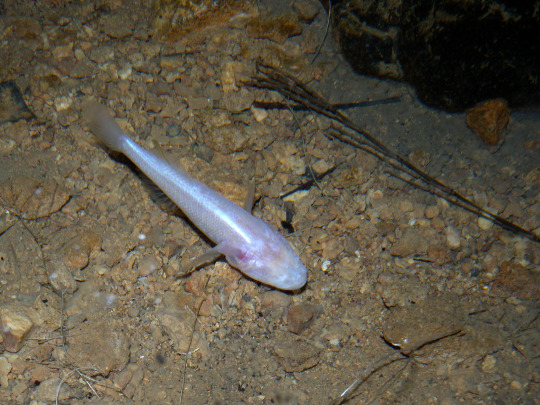
(Image: Typhleotris madagascariensis, a typical cave fish. It is a small fish with an entirely white body and smooth skin where the eyes would be on a normal fish. It is resting on rocky sediment. End ID)
Caves are not an easy place to live. There's no light, limited food, often low oxygen levels, and the threat of collapse or rockfall. Cave-swelling animals (collectively called troglofauna) need a number of special adaptations to survive and there is little room for error. Troglofauna that are strictly aquatic are called stygofauna. Troglofauna and stygofauna can be divided into three groups based on their life history. Troglophiles and stygophiles complete part of their life cycle in caves and part outside of them. A classic example of this is the many species of bat who seasonally inhabit caves to give birth and mate. Trogloxenes and stygoxenes are animals who will visit caves, but do not require time in caves to complete their life cycle. An example trogloxene would be a bear who takes shelter in a cave during winter. Finally, troglobites and stygobites live their entire lives in caves and never leave. The fish I discuss today are stygobites. Because troglobites and stygobites generally will die outside of their caves, they have very little opportunity to disperse. As such, many cave fish species are found only in a single cave or cave system and are entirely dependent on the health of their homes to survive.
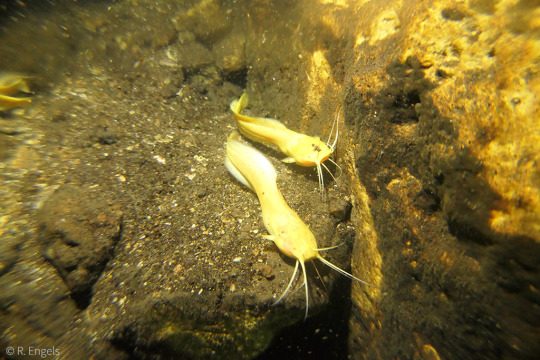
(Image: two cave catfish sitting next to each other on a rock. They are white with elongated anal and rear dorsal fins, and no eyes. End ID)
Many cave-dwelling animals develop a set of common adaptations called troglomorphism. Cave water is often high in minerals but low in oxygen and food content. To survive, the fauna develop very slow metabolisms, allowing them to last a long time on limited resources while slowing down movement and other active systems and increasing age. These species are also typically smaller than their epigean (above-ground) relatives, further reducing their energy requirements. Slowed metabolism results in comparatively slow development. Cave species take much longer to mature and reproduce then related epigean species. Many species further decrease their energy consumption by moving as little as possible. Many species of cave fish are able to last long periods of time between meals without negative impacts to their health. They will binge eat whatever they can find and then subsist on fat stores while food is scarce. One test in captivity showed that a Phreatobius cisternarum (cave catfish) could go a while year between meals and stay healthy. Cave species are usually opportunistic generalists as they can't afford to pass up resources. Much of their food will originate outside of the cave, either directly or indirectly. Water flow into caves brings in algae, bacteria, plankton, and other food sources. Other more indirect methods of introducing include bat feces. While the fish may not eat the feces directly, other species may do so and potentially become prey to the cave fish. The feces also introduces nutrients from outside the cave that encourages the growth of other food sources like bacteria, fungi, and planktonic animals.
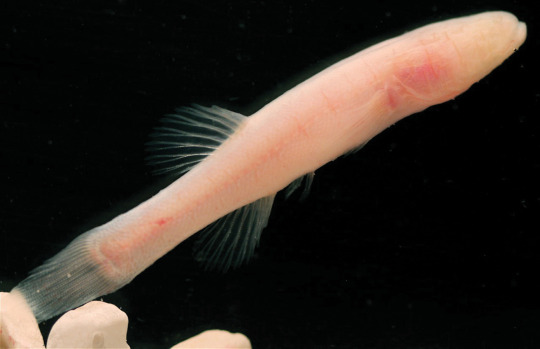
(Image: Amblyopsis hoosieri, the hoosier cave fish. It is a very simplistic fish with no eyes or scales. End ID)
Life in a cave comes with a different sensory requirement. The complete lack of light makes vision useless. You don't know dark until you've seen cave dark. Fun fact: caves are so dark that sighted people can start hallucinating in them because our brains aren't evolved to handle zero visual stimulus and will start making stuff up to fill that gap. As a result of the utter darkness, many species of cave fish are blind. They either evolve to completely lose their eyes or have the eyes considerably reduced in size and function. Eyes take up a lot of energy to maintain and in caves, there is a lot of selective pressure to get rid of organs that aren't useful there. Despite the blindness, many species retain some form of photosensitivity and will flee from light. Cave species also often lack skin pigmentation. Skin pigment has two primary uses. It protects the skin from ultraviolet light in sunlight, and provides skin coloration that can be used for camouflage, displays, warnings, and so on. In an environment where there is no ultraviolet light and everyone is blind, skin pigment serves no real purpose and is lost. As a result, most cave species are white or translucent. The lack of pigment may be a reason so many species remain photosensitive. Without pigment, they would be highly susceptible to sunburn or skin cancer from ultraviolet light. Caves also have a sound dampening effect that makes hearing less valuable. Reduced eyes and pigmentation is also seen in deep sea fish that live too deep for light to reach. Even those species still use visual curs more than cave fish due to the abundance of bioluminescence in the deep ocean.
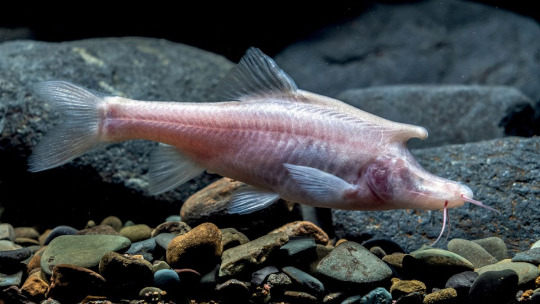
(Image: Sinocyclocheilus longicornus, a recently discovered species. It is a fish with translucent skin, revealing the skeleton. It has a long shout with two pairs of barbels. Emerging from the upper back is a horn-like protrusion. End ID)
With vision off the table, cave fish rely on other senses. chemoreception through taste and smell are strongly selected for as traits that can direct cave animals toward food or away from threats. Another sensory system fish have is the lateral line. The Lateral line is an organ system found on each side of a fish where modified skin cells called hair cells detect motion in the water. The lateral line allows fish to sense movement in the water around them, informing them of water flow and the movement of food and threats. Cave fish typically have a well-developed lateral line system that compensates for the lack of vision. Many fish perform displays for various reasons, such as attracting mates. These displays are typically visual, but in cave fish, that isn't an option. Instead, their displays are more focused on moving the water in ways that can be detected by lateral lines. Some species of cave fish maintain additional sensory abilities from their epigean ancestors. An example of this are cave catfish, who retain the barbels and electroreception common to their kind.
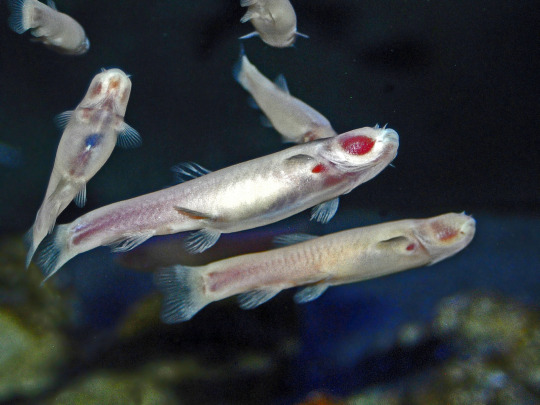
(Image: six Phreatichthys andruzzii. They are long, eyeless, white fish. The blood-filled gills are visible through its translucent skin, seen as a large red patch on the head. End ID)
Before moving on to specific species, it should be noted that cave fish is not a taxonomic category. Cave fish come from many different lines of descent and independently evolved similar adaptations to cave conditions. These similar adaptations are seen in most cave fauna, not just fish, and are collectively called troglomorphism. There are about 300 species of cavefish known to science.
Ophisternon candidum, or the blind cave eel, lives in north Australian caves that are connected to the ocean. Because these caves intake salt water, the pools and streams within them can become very salty, resulting in the eels developing a tolerance to a high range of salinity. They are rare, having been spotted under 40 times since 1959, and thus little is known of their lifestyle. We do know they burrow into sediment and secrete mucus to keep those burrows stable. Males seem to build burrows to woo females. They have been bred in captivity for use un laboratories. At up to 40 cm long, they are huge for cave fish and used to hold the record for the largest species known until another species was found that's even bigger.
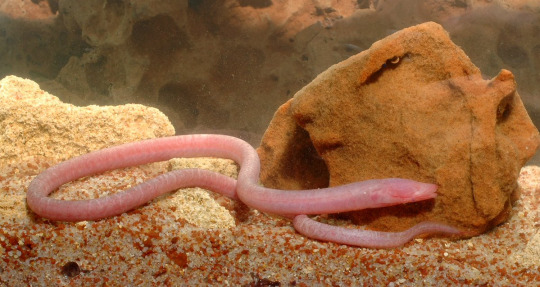
(Image: an eel with translucent, pink skin, no eyes, and ribs visible through the skin. It looks somewhat like an earthworm. End ID)
The actual largest known cave fish is Neolissochilus pnar, which gets up to 40 cm while being more massive than the eel. They are found in a single cave system 100 meters underground in India. The primary food source in the cave appears to be debris from the nearby forest that is washed into the cave during seasonal flooding. The fish may have been known to locals well before it was scientifically described, as there are stories of white cave fish going back over a century in the region.
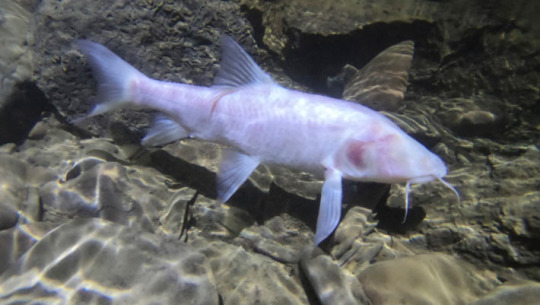
(Image: a small fish with no eyes, white skin, and a long snout with barbels on it)
The Alabama cave fish (Speoplatyrhinus poulsoni) may be the rarest species of freshwater fish in the world. They live exclusively in key cave, Alabama, USA and no more than 10 have ever been seen at a time. The population is estimated to be under 100, below the generally accepted minimum viable population for a species of 200. Fittingly enough, this means a species only found in Alabama may be severely inbred. They are believed to be triggered to mate by seasonal flooding and may be mouth brooders. Climate change-caused changes to flooding and toxins leaking into the groundwater from sewers are currently threatening them with extinction.
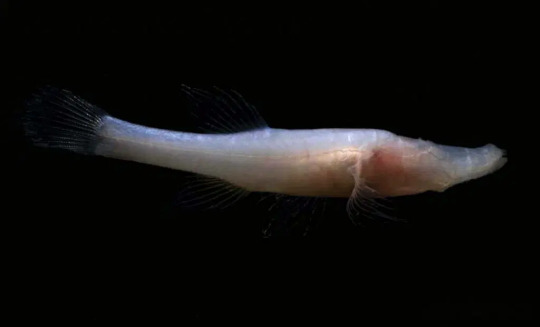
(Image: a long, white, eyeless fish with an elongated snout. Its skeleton is visible through its skin. End ID)
Typhliasina pearsei, the Mexican blind brotula or dama blanca ciega (blind white lady), lives in the cenotes of the Yucatán peninsula. Cenotes are sinkholes filled with groundwater and the ones in the Yucatán are often connected by underground caves, rivers, and aquifers. The fish are apex predators who eat shrimp and mysids and are known to coexist with other cave fish in part of their range. As with other brotulas, they are a rare example of a bony fish that gives live birth. Because of how interconnected and numerous the cenotes are, this species has one of the largest distributions of all cave fish.

(Image: an eyeless white fish with a long tail and elongated rear dorsal and anal fins. It is next to an orange rock. End ID)
Cryptotora thamicola, the cave angel fish or waterfall climbing cave fish, is the adrenaline junkie of the cave fish world. Most cave fish live in slow-moving or still water, but this daredevil lives in rapids. But just living in rapids isn't extreme enough, these guys climb waterfalls. Their large fins with hooked fin rays let them cling onto the rocks while facing into the current. They then allow food to flow right into their mouths. Unlike other walking fish, the waterfall climbers have a well-developed pelvic girdle and walk in a style very similar to tetrapods, with front and back fins alternating strides. This has made them very interesting to evolutionary biologists studying the transition from fish to tetrapods.
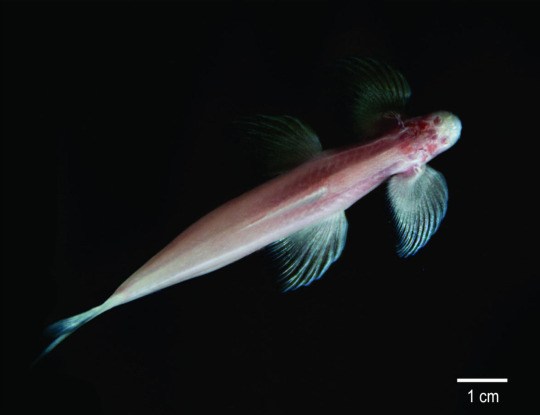
(Image: a typical cave fish with very large pectoral and pelvic fins. End ID)
The Mexican tetra (Astyanax mexicanus) is an example of a handful of fish species that have a cave form and a non-cave form. Most Mexican tetras are perfectly ordinary tetras, but one population has adapted to cave living and has developed trogomorphic traits. The cave from lack pigment, has tastebuds on its head, lacks eyes, and can store more body fat. While you would expect such radical physiological differences to mean the two populations are different species, they aren't. The two populations are fully capable of producing fertile offspring and do so in the wild. If you've ever seen a cave fish in person, there's a good chance it was one of these as the cave form has entered the pet trade and they do very well in captivity, making them the most studied cave fish.
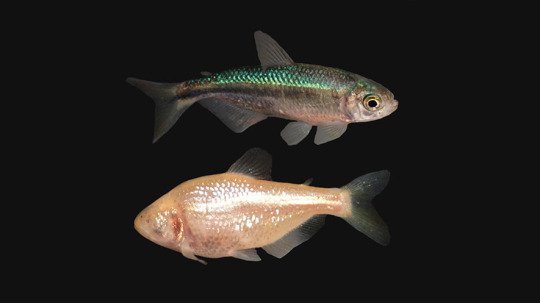
(Image: the non-cave and cave forms of the Mexican tetra seen next to each other for comparison. The non-cave form is a fairly typical silvery-green fish. The cave form is slightly more robust, white, and eyeless. End ID)
Because most cave fish are found only in a singe cave or cave system, they are fully dependent on the health of that cave. Caves tend to be very stable environments, which results in the inhabitants being pretty bad at adapting to change. Changes in water flow, introduction of new species, and pollutants can seriously harm or wipe out whole species. Many species of cave fish are rated as endangered or critically endangered based on their low populations and vulnerability to change.
#wet beast wednesday#I went into this thinking it would be quick and easy to write.#and now it's 6 hours later#cave fish#cave animals#troglofauna#cave#caves#fish#fishblr#fishposting#aquatic life#aquatic biology#biology#zoology#ecology#animal facts#evolution#informative#image described#educational#speleobiology
593 notes
·
View notes
Text
Book recs: the evil fungi did it
We all know of The Last of Us, but that franchise isn't the only example of fungal invasions. We've got zombies and apocalypses, we've got gothic horror, we've got fantasy, we've got romance, we've got space - no genre is safe from having their characters become the home of fungal organisms.
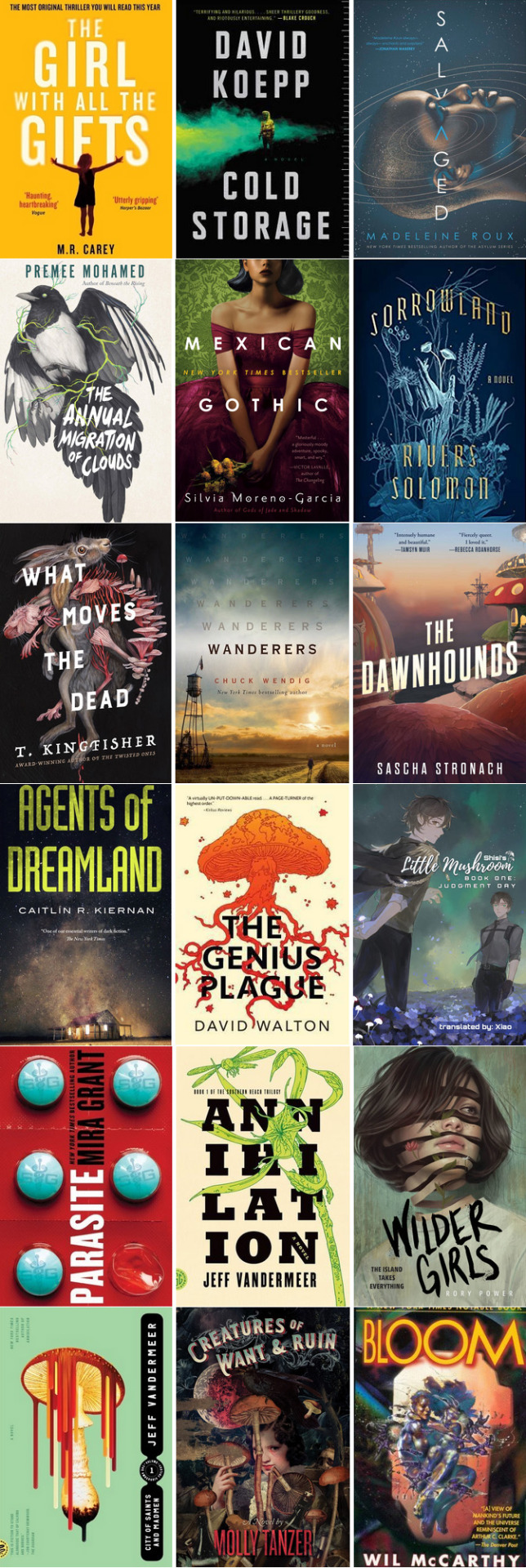
For more details on the books, continue under the readmore. Titles marked with * are my personal favorites. And as always, feel free to share your own recs in the notes!
If you want more book recs, check out my masterpost of rec lists!

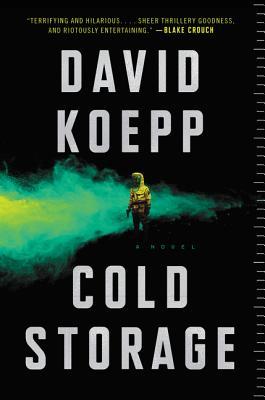
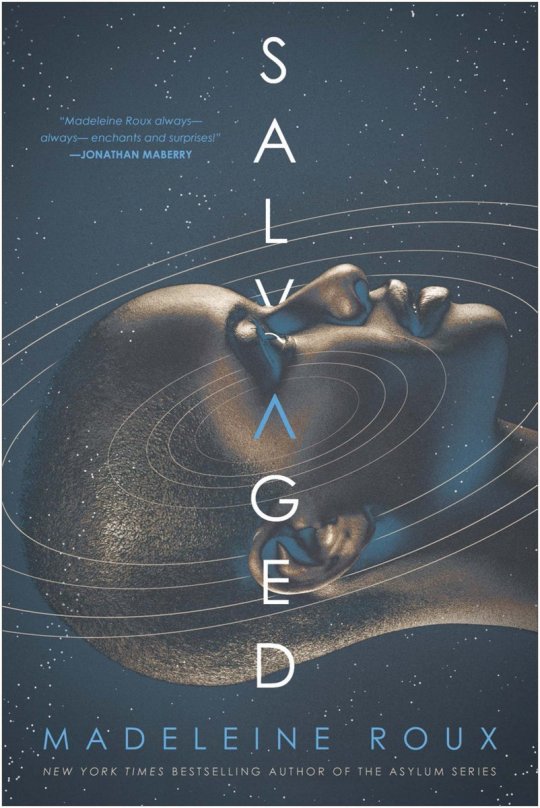
The Girl with all the Gifts (The Girl with All the Gifts series) by M.R. Carey
Want another fungal zombie apocalypse? Then I come bearing great news! The Girl with All the Gifts is a post apocalyptic novel following a group of characters fleeing across an infested wasteland, trying to stay alive and hoping to find a cure. One of the characters is Melanie, a young girl who carries the contagion inside of her and hungers for flesh, but like many children of the apocalypse has kept her humanity. Is she and children like her the answer to the cure we are looking for? Or are they the start of something entirely new? This book has also been adapted as a movie!
Cold Storage by David Koepp*
Years ago, a quickly growing fungal organism capable of wiping out humanity came dangerously close to spreading. It was contained and kept in cold storage underneath a military repository. Since then, a larger storage facility has been built on top, the dangers on the lower floor being largely forgotten. That is, until it makes a new attempt at escape. Now, two unsuspecting security guards might be all that stands in the way of complete extermination. This book is both funny and genuine in its characters, and genuinely creepy in its portrayal of body horror.
Salvaged by Madeline Roux
Rosalyn Devar is on the run from her famous family, and has run so far she ended up in space. Now she works as a "space janitor", being sent off to clean up the remains of failed research expeditions. But in trying to cope with her problems, she has fucked up on her job multiple times, and is now close to losing her position. Her last chance is the Brigantine: a research vessel gone silent, all crew presumed dead. But when she arrives to salvage it, Rosalyn discovers the crew isn't as dead as presumed. But are they still human - and will Rosalyn be able to keep her own humanity?
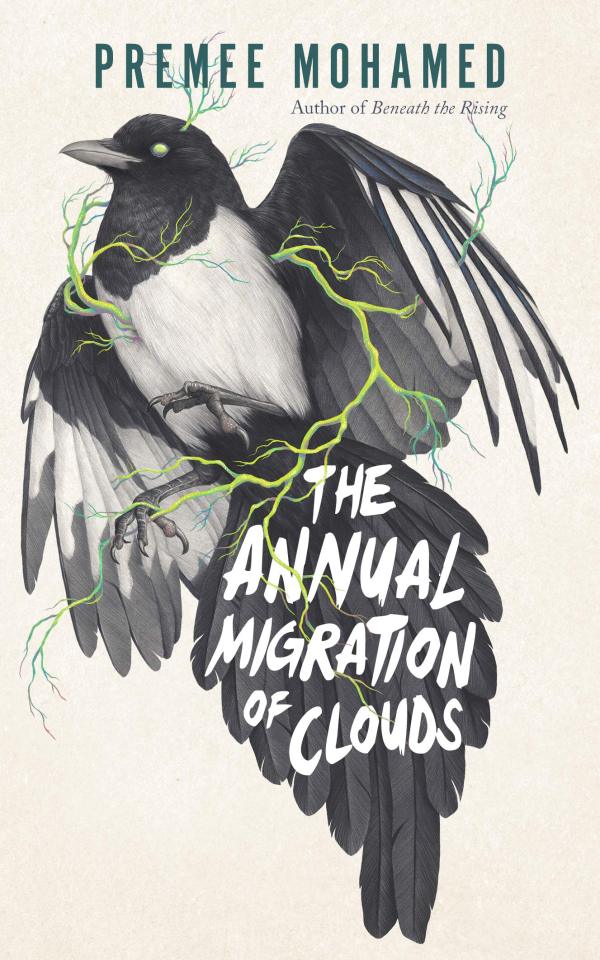


The Annual Migration of Clouds by Premee Mohamed
Novella. Reid is a young woman living in a small community after a climate collapse. Resources are scarce, but Reid's biggest problem is Cad, a mind-altering fungal parasite that lives inside her body. When she is offered a rare chance at attending a far-away university in a secluded dome community, Reid must decide whether to leave or stay to help support her community.
Mexican Gothic by Silvia Moreno-Garcia*
Noemí Taboada is a glamorous and well-off young woman, but when she receives a frantic letter from her newly-wed cousin, Noemí must leave her glamorous life and travel to find out what is wrong. As she arrives at High Place, a mansion on the Mexican countryside, Noemí is met with mysteries and her cousin's new English family. As she tries to find out the truth behind High Place and its inhabitants, Noemí's only ally is the youngest son of the family. But will she be able to find out what so scared her cousin before it's too late for all of them?
Sorrowland by Rivers Solomon
A young pregnant woman flees a cult that left her body strange and changing in terrifying ways. Hiding from both a world wanting to oppress her and the cult seeking to force her back, she does her best to raise her children while trying to find out the truth of the cult and being pursued by a hunter in a dangerous game of cat and mouse. Bleak and scary, Sorrowland is a book that will creep under your skin with horrors both fantastical and very, very real.
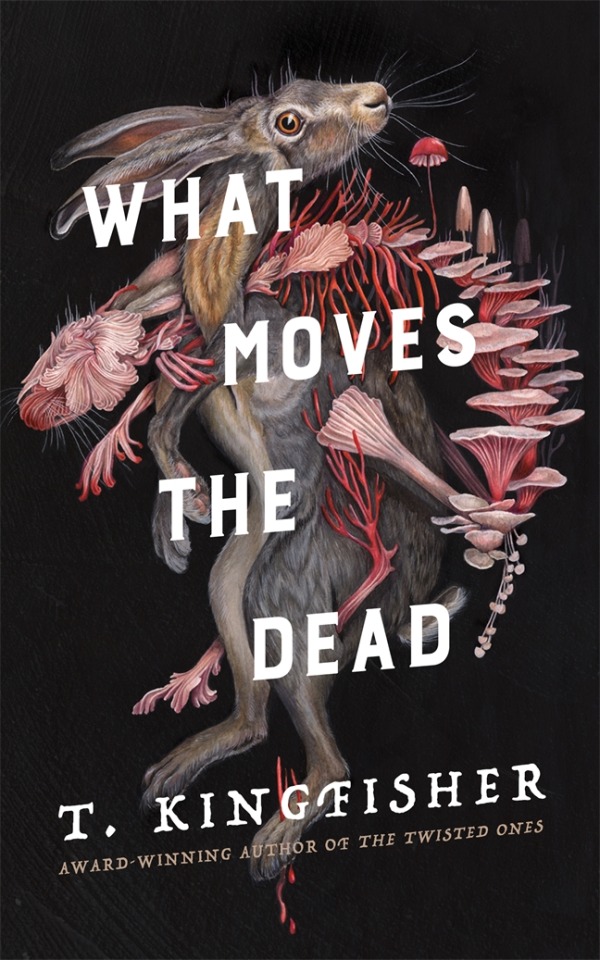

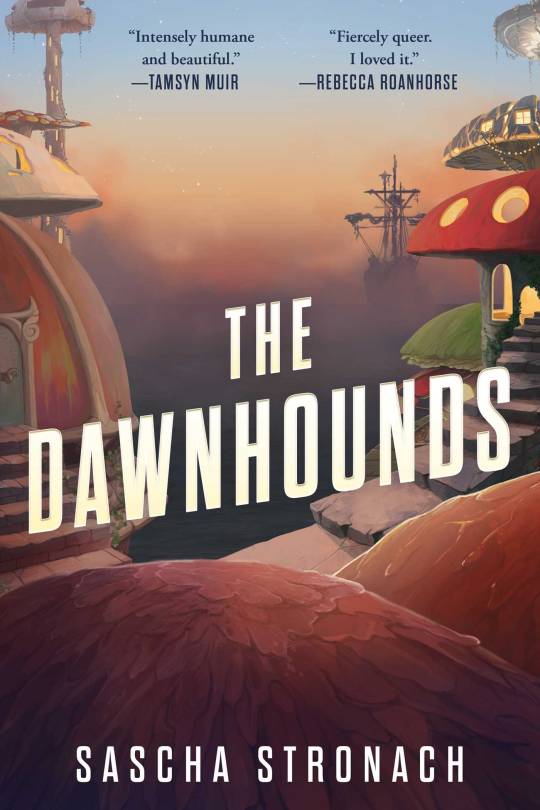
What Moves the Dead (Sworn Soldier duology) by T. Kingfisher
Novella. Alex Easton, retired soldier, travels to visit their childhood friends, siblings Madeline and Roderick Usher, after finding out that Madeline is dying. In the siblings' rural, ancestral home, Madeline walks in her sleep and looks to be fading away, while around it wildlife seems to be possessed by a strange force. With the help of a mycologist and an American doctor, Alex attempts to save Madeline and reveal the truth of her illness.
Wanderers (Wanderers duology) by Chuck Wendig
A strange illness has struck the United States: with no warning, random people with seemingly no connection simply get up and start walking. They do not eat, do not sleep, do not communicate, and they do not stop - and if you try to force them, they literally explode from the inside. Teenaged Shana isn't one of these sleepwalkers, but her little sister is. Unwilling to leave her sister on her own, Shana accompanies the growing flock of walkers, protecting them as one of many "shepherds". And this protection proves necessary, as the sleepwalkers is only the first step toward what might very well be the extinction of the human race. An 800 page epic, Wanderers is a slowburn apocalypse story with a multitude pov characters and plot threads, from fungal pandemics and all-knowing AI to the all too real portrayal of radicalization and bigotry.
The Dawnhounds (The Endsong series) by Sascha Stronach
The Dawnhounds is a book where you just kind of have to let the story and the world wash over you. It skirts the line of scifi and fantasy, with a futuristic world of environmentally friendly mushroom houses and deadly fungi bio weapons next to literally god-given superpowers and near-immortality. It’s really cool and unlike anything else I’ve ever read, but also a bit confusing. Bonus: it’s also sapphic!


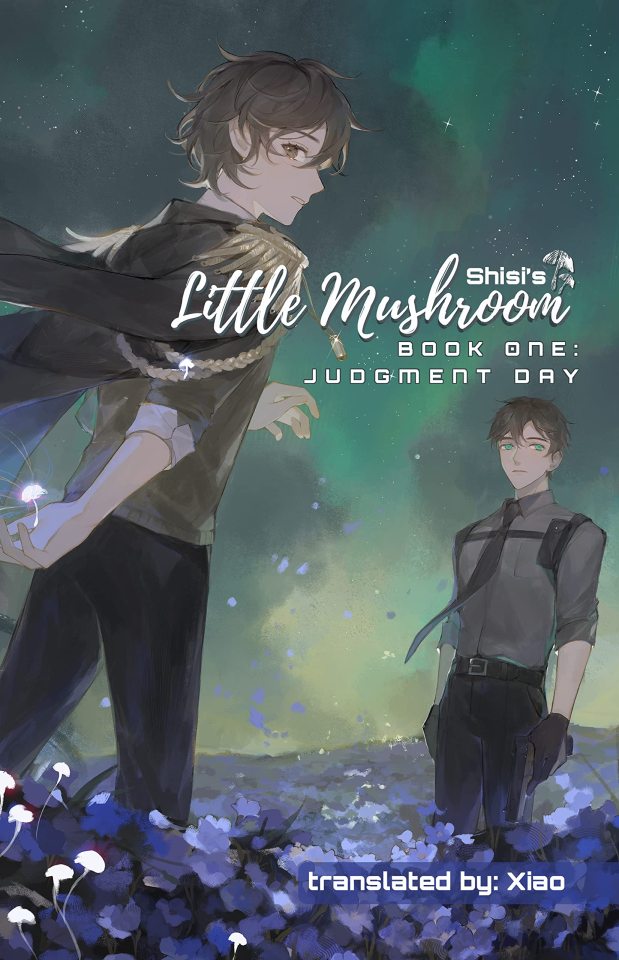
Agents of Dreamland (Tinfoil Dossier trilogy) by Caitlín R. Kiernan
Novella. A government agent known only as the Signalman; a cult preying on the young and vulnerable, promising to usher in a new age; a woman who exists outside of time, searching for a way to save humanity. Agents of Dreamland is short, but includes many spooky elements, among them an alien and possibly world-ending fungi. The narrative is non-linear and a bit strange, but also fascinating.
The Genius Plague by David Walton
Soon after landing his dream job at the NSA, things get weird for Neil Johns. His brother Paul, a mycologist, returns from a trip to the Amazon, carrying a nearly lethal fungal infection and a strangely sharpened mind. At work, Neil starts picking up mysterious messages originating out of South America, where cases similar to that of Paul starts occurring. And strangest of all: all the infected seem to be working towards the same goal. Recommended with the caveat that, while the fungal stuff is really cool, The Genius Plague is also happy to idolize American intelligent agencies and demonize environmentalism and anti-imperialism.
Little Mushroom: Judgement Day (Little Mushroom duology) by Shisi
An Zhe isn’t human. He’s a mushroom who absorbed the DNA of a dying man, allowing him to take on human guise and leave the wilderness. Entering one of the last human bases, a place struggling to keep out the mutated and dangerous creatures of the wilds, An Zhe must keep his identity secret as he searches for something which was taken from him. While not my cup of tea (frankly, I need more female characters), Little Mushroom is an undeniably unique m/m romance novel.
Bonus AKA these don't technically involve any fungi but have similar vibes of parasites and nature corrupting the human

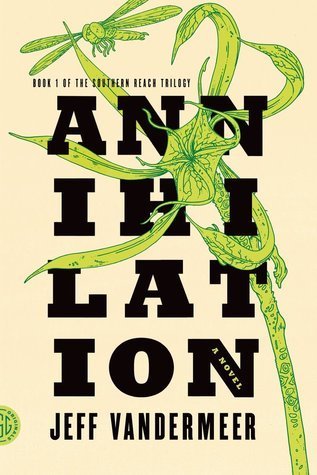

Parasite (Parasitology trilogy) by Mira Grant*
In the near future, a great leap in medical science has improved human health by leaps and bounds: a genetically engineered tape worm. Within a few years, almost every human has their own personal parasite implanted. But now, something is happening to the parasites - they want more, whether their hosts want to share or not.
Annihilation (Southern Reach trilogy) by Jeff Vandermeer
For decades, Area X has been completely cut off from humanity. The only ones to enter are small organized expeditions, many of which never return, or return... wrong. We follow the latest expedition, its participants known only as the anthropologist, the psychologist, the surveyor, and our narrator, the biologist. As they enter into Area X to try to find out its secrets, only one thing is for sure: they will never be the same again.
Wilder Girls by Rory Power
Young adult. Over a year ago, the Raxter School for Girls was hit by the Tox, a strange disease that killed off many and left the survivors' bodies slowly changing in terrifying ways. The island the school is on has been in quarantine since then, and the girls dare not leave the school grounds lest they become victims of wild animals changed by the Tox. But as they wait for the promised cure, one of the girls goes missing, and her friends are willing to do anything to find her. Unsettling, spooky, and sapphic, this is a unique read featuring body horror and messy, dangerous girls.
(Second) Bonus AKA I haven't read these yet but they seem really cool

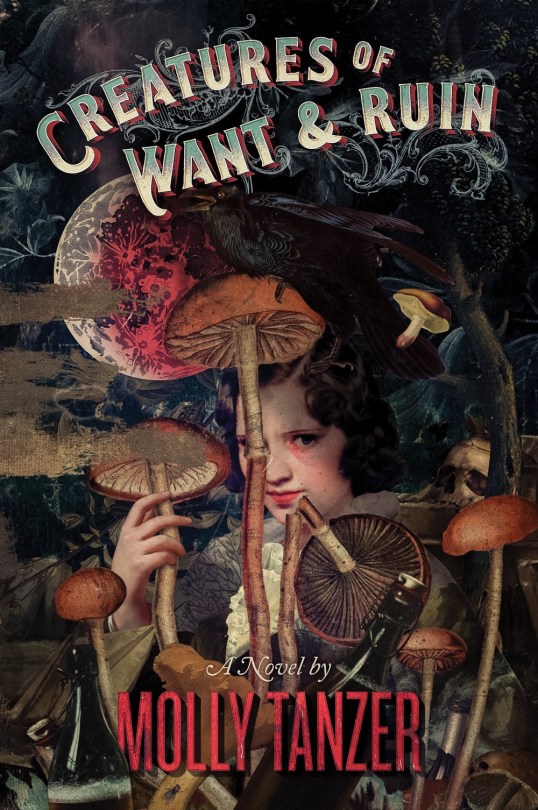

City of Saints and Madmen (Ambergris trilogy) by Jeff Vandermeer
Ambergris, a city created by a mushroom-like people, is now the home of humans, but the original inhabitants are still there, residing beneath the city.
Creatures of Want and Ruin (Diabolist's Library series) by Molly Tanzer
It’s the prohibition era, and while Ellie does fishing during the day, at night she bootlegs moonshine in Long Island. But unbeknownst to Ellie, some of the booze she smuggles has a strange source: distilled from mushrooms by a cult, it causes those who drink it to see terrible things, such as the the destruction of Long Island.
Bloom by Wil McCarthy
The inner solar system has been overtaken by fast-reproducing, fast-mutating technogenic life. Humanity has fled to the outer solar system, hiding beneath the ice of Jupiter's moon, but even here they aren't safe from possible incursion of mycospores, which lead to deadly blooms. Now a group of astronauts venture back to an infected Earth.
#the girl with all the gifts#cold storage#salvaged#the annual migration of clouds#mexican gothic#sorrowland#what moves the dead#wanderers#the dawnhounds#agents of dreamland#the genius plague#little mushroom#parasitology#annihilation#wilder girls#nella talks books
805 notes
·
View notes
Note
With tube plants, I’m really curious if any are edible, and if so what’re they like, and how avian culture sees them. While Taxonomically they’re animals, does avian culture consider them plants? For a random example, let’s say the avians, like us, had a religious period where they can’t eat meat. Would worm plants be considered off limits, or the same as anything else? Not saying that religion or whatever exists, it’s just the first frame of reference I could think of. Another example might be how fungi are considered vegetables, but are an entirely different kingdom.
As for eating, I’m curious if they have a more meat-like texture and taste, or a more plant-like one. I’m assuming the former. If they’re eaten, what are the parts that are eaten and how are they usually prepared? Do the avians have any traditions or culture regarding the tube, like we do with wishbone breaking or bone carving? Is it possible to farm them, and are they?
Avian cultures usually classify plantworms in the same group of food as shellfish, which they resemble the most nutritionally. They are more like a clam than a plant. Many are toxic as a defense against being eaten, but the ones avians can consume are usually cooked whole (in or out of shell) unless a specific body part is unpalatable (usually the gut or frond tentacles). For larger worms, they may be trimmed down to the tastiest part, the retractor muscle. It's very possible to farm them, and many are also cultivated for their beauty as landscaping plants. Their tubes are most commonly used to make plaster for building, or beads.
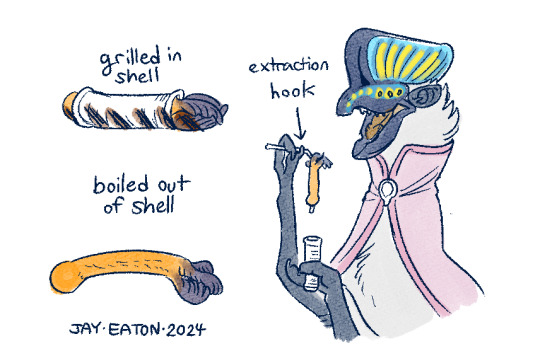
Vegetarianism is overall more rare in avian cultures than ours because they have a higher calorie-per-pound requirement than humans and many live on small islands where grain agriculture is more difficult to live off exclusively than fishing. There are several grades of culturally distinct pescetarian diets in modern avian cultures though, some of which view eating large "vertebrates" as unacceptable, land animals as unacceptable, vertebrates in general as unacceptable, only plantworms are acceptable, or hardline only plant matter and eggs (which may or may not include plant worm "leaves and flowers"... which can grow back). Hardline vegetarianism or veganism is more common among flightless avian cultures, who historically have had the most arable land.
731 notes
·
View notes
Text
Gonna be honest i don't think you can apply cladistics or taxonomy to rain world.
Lizards aren't actual lizards, not reptiles or even vertebrates. I don't think dropwigs are arthropods, insects or even bilaterians. I don't think pole plants are animals, plants, fungi or protists.
As I see it every living thing you see in the game is a descendant of a purposed organism.
Purposed organisms which had genes taken from everywhere in the tree of life.
Genetics has become a muddied pool of organisms which, for example have 32% of their dna from protists, 7% from arthropods, 31% from vertebrates, 16% from fungi and 14% from scyphozoa.
The ancients influence has left the entire concept of genetics and taxonomy useless in a world where what looks like two members of the same clade have almost nothing in common but simply both adapted for similiar niches.
The concept of an animal, plant, or even a pure eukaryote no longer exist.
#boiled electronics#rain world#rw#rw lore#rain world lore#i will be happy forever if one(1)person enjoys this post
617 notes
·
View notes
Text
In today's age of magic, shapeshifting has never been easier or more frequent. Have you started to notice your partner has some strange quirks? Does your husband, wife, spouse or significant other demonstrate some odd behaviours that you've only started to take real notice of after significant time together? Accidentally getting into a relationship with a nonhuman is more common than you might think. Here's a handy guide on some entities your partner might be, in case you feel you need to approach that topic.
1 - Fae
Fae are a very diverse race, ranging wildly in appearance and power, and disguising themselves as humans is an everyday occurrence. You most likely grew up on stories about not giving your name to strangers, in case they are Fae - unknowingly marrying a Fae is shockingly common, the Bureau of Nonhuman Entities (BoNE) estimates that anywhere between 0.5 to 2% of human marriages actually include one or more Fae in disguise. Here are the signs your partner may be Fae.
A 'green thumb', very knowledgeable about highly local plants and fungi
Strong aptitude for poetry and instruments, a very beautiful singing voice. They highly enjoy writing songs for you, composing poems about you, and singing together.
Enjoys singing you to sleep.
Wild animals are completely unafraid of them, and often approach both of you
Loves gold jewellery, but abjectly refuses to wear anything silver.
Sees suspiciously well in the dark
Cannot get drunk - Fae are often immune to human poisons
Acquaintances of yours describe your partner as 'ethereal', 'enchanting', or 'hypnotising'. You may hear comments that your partner seems out of your league.
They place a very heavy emphasis on manners and politeness, and can quickly grow upset when social rules are not followed.
When frustrated, they use swear words you've never heard before
Fae are frequently attracted to neurodivergent humans. If you're neurodivergent the likelihood is even higher.
2 - Deity
Again, more common than you might think. Deities both minor and major often find themselves attracted to humans, and stories of these romances are baked into our histories. Your spouse may be the God of anything from a very specific kind of flower, to a certain weather pattern, to (rarely) something very big like knowledge or the ocean itself. They're harder to spot than Fae, often indistinguishable from a normal human thanks to their many years observing people.
The biggest clue is that they don't notice pain, and never seem to get hurt. They'll have invulnerability or high resistance to things such as burning, freezing, drowning, cutting, and blunt force trauma. They might not notice they've put their hand on a hot burner, for example.
Speaks in strangely archaic language, often misunderstanding modern trends and linguistics. Oddly knowledgeable around ancient subjects.
They may randomly smell like blood and/or smoke. This is often a sign they've just received an offering, and the intensity of the smell is stronger with more powerful deities.
They can immediately tell when someone is lying, usually without giving a cause for the knowledge.
The two of you share pet names of a celestial nature, such as "star", "nova", "sun", "moon", "comet".
When upset, they have a highly commanding voice that can shake glass or cause bizarre events to happen (ie; mist indoors, words on a page scrambling, lights changing colour).
Heightened interest in the topic of immortality - particularly your views on it. Frequently asking you 'how you would feel' if you would live forever.
3 - Dragon
A very rare (but not impossible) phenomena, most people have no idea that dragons are intelligent and emotionally complex beings that can very convincingly disguise themselves. Living in caves isn't for everyone and loneliness is not just a human feeling.
Very wealthy, but with no clear sign of where the wealth originates from. They may say their money comes from a 'long-term investment'.
Highly passionate lover. Deeply devoted and affectionate, sometimes to the point of it being inappropriate in public. Enjoys big displays of affection and physical intimacy. May need to be told to slow down.
Abandonment issues. This often stems from the highly violent childhood many dragons experience, and the frequent loss of loved ones to dragonslayers. They might be reluctant to be separated too long.
Has a particular item they enjoy hoarding. This could be clothes, trinkets, plushies, shoes, anything at all. You may find that they're very easygoing about you touching their collection, maybe they even actively make you part of the hoard. They may dress you in collected clothes, sort their collected plushies around your bed, or ask you to wear jewellery they've found. But they'll become extremely agitated and aggressive if anyone other than you tries to interact with 'their things'.
Prone to anger, quick-tempered.
Frequently concerned about your health, seems to perceive you as delicate and easily injured.
Please remember that if your partner IS nonhuman, they almost certainly didn't intentionally lie. Human relationships will seem very fast to other entities. Many transform into humans for a fun year out, find themselves head over heels in love, and then can't figure out the right time to tell their human lover the truth. Try not to hold it against them, everyone has their quirks!
531 notes
·
View notes
Text

A word on diet of a Nix-Hound.
The public's well aware, I think, these creatures are hematophages i.e. they drink the blood of other animals. But blood's not the only (and not the most important) fluid they sustain themselves upon. Egg yoke is—indeed: ransacking egg nests is the primary way Nix-Hounds menace other animals (almost all of whom, on Vvardenfell, are egg-laying). Also, Nix-Hounds are the primary predator of juvenile forms of Kwama—worm-like Kwama Foragers—whom they are able to dig out of the ground with their enormous, spade-like feet. Kwama eggs thus are the quintessential delicacy and given the ubiquity of egg mines on Vvardenfell, this has ensured domestication of the species by the Dunmer people. A more exotic still example of a food source are the bulbous pustules of some Bittercoast fungi which Nix-Hounds drain of their fetid liquid—thus, evidently, aiding the process of spore dispersal through digestive action.
P.S: Digital painting. Made in Krita. Feel free to repost, reblog and whatever else.
#morrowind#elder scrolls#tamriel#nixhound#nix-hound#tes 3 morrowind#morrowind lore#vvardenfell#digital art#digital painting#tes#the elder scrolls#tesblr#fantasy art#art#artists on tumblr#illustration#krita#made with krita#digital artist#digital illustration#dunmer#tes art#kwama
247 notes
·
View notes
Text
HELLO ART LOVERS!


💸🦢 you can NOW exchange money for beautiful artworks by ME, TODAY!! to request a commission, email me at [email protected] and we can talk about what you want me to draw and how much it will be!
prices will vary depending on complexity, color, and how familiar i am with drawing the subject! minimum is $45 for simple lineart of a single subject. see examples for pricing estimates, and email me if you have questions!
my favorite subjects to draw, if you want ideas; weird birds, cave-art inspired animals, abstract compositions of multiple subjects, specific bugs, fishies, morbid concepts, homages to a species, life cycles, non-human apes, skeletons, unique plants, fungi, vultures, realistic nature backgrounds, mold, colerful creatures, bugs with bad reputations, city animals, dinosaurs, faux stamps
**please don't request pet portraits, humans, or mechanical subjects
payment up front via venmo - if venmo isn't available for you, alternatives are available 💸
#my art#commissions open#animal illustration#nature illustration#biology art#creatures#bug art#bird art#trans artists#🪲
223 notes
·
View notes
Text
Parasitic plant convinces hosts to grow into its own flesh—it's also an extreme example of genome shrinkage
@bogleech I feel you'd be interested in this if you aren't already aware of it.
903 notes
·
View notes
Text
[Hanfu · 漢服]Chinese immortal Hanfu <灵芝玉女/Goddess holding Ling Zhi> Based On Yuan Dynasty Taoist Temple Mural<永乐宫/Yongle Palace>







【Historical Artifact Reference】:
▶ China Yongle Temple(永乐宫) Murals showing<灵芝玉女 / Goddess holding Lingzhi>
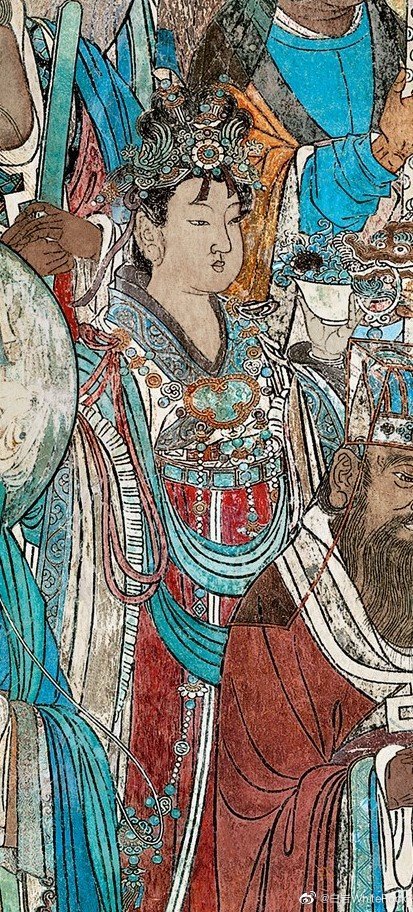

🍄The significance of Lingzhi in China🍄
In Chinese art, the lingzhi symbolizes great health and longevity, as depicted in the imperial Forbidden City and Summer Palace.It was a talisman for luck in the traditional culture of China, and the goddess of healing Guanyin is sometimes depicted holding a lingzhi mushroom
The Old Chinese name for lingzhi 靈芝 was first recorded during the Han dynasty (206 BC – 9 AD). In the Chinese language, língzhī (靈芝) is a compound. It comprises líng (靈); "spirit, spiritual; soul; miraculous; sacred; divine; mysterious; efficacious; effective)" as, for example, in the name of the Lingyan Temple in Jinan, and zhī (芝); "(traditional) plant of longevity; fungus; seed; branch; mushroom; excrescence"). Fabrizio Pregadio notes, "The term zhi, which has no equivalent in Western languages, refers to a variety of supermundane substances often described as plants, fungi, or 'excrescences'."Zhi occurs in other Chinese plant names, such as zhīmá (芝麻; "sesame" or "seed"), and was anciently used a phonetic loan character for zhǐ (芷; "Angelica iris"). Chinese differentiates Ganoderma species into chìzhī (赤芝; "red mushroom") G. lingzhi, and zǐzhī (紫芝; "purple mushroom") Ganoderma sinense.
In the chronicles of Shiji (1st century CE from Sima Qian), the initial use of nearby separately related words with Chinese: 芝 and Chinese: 靈 are attested to in the poems of Emperor Wu of Han. Later, in the 1st century CE through the poetry of Ban Gu, occurred the first combination of the characters 靈芝 together into a single word.
_______________
📸Photography post-production :@小何力
👗Hanfu & 👑Crown:@雁鸿Aimee
👭Model:@清音音音音
💄 Makeup:百丽 (临溪摄影)
🔗Weibo:https://weibo.com/1615560544/O267AzTqM
_______________
#chinese hanfu#immortal hanfu#hanfu#hanfu accessories#hanfu_challenge#chinese traditional clothing#china#chinese#chinese style#chinese mythology#漢服#汉服#中華風
177 notes
·
View notes
Text
Making worlds is not limited to humans. We know that beavers reshape streams as they make dams, canals, and lodges; in fact, all organisms make ecological living places, altering earth, air, and water. Without the ability to make workable living arrangements, species would die out. In the process, each organism changes everyone’s world. Bacteria made our oxygen atmosphere, and plants help maintain it. Plants live on land because fungi made soil by digesting rocks. As these examples suggest, world-making projects can overlap, allowing room for more than one species. Humans, too, have always been involved in multispecies world making. Fire was a tool for early humans not just to cook but also to burn the landscape, encouraging edible bulbs and grasses that attracted animals for hunting. Humans shape multispecies worlds when our living arrangements make room for other species. This is not just a matter of crops, livestock, and pets. Pines, with their associated fungal partners, often flourish in landscapes burned by humans; pines and fungi work together to take advantage of bright open spaces and exposed mineral soils. Humans, pines, and fungi make living arrangements simultaneously for themselves and for others: multispecies worlds.
Anna Lowenhaupt Tsing, The Mushroom at the End of the World: On the Possibility of Life in Capitalist Ruins
128 notes
·
View notes
Text
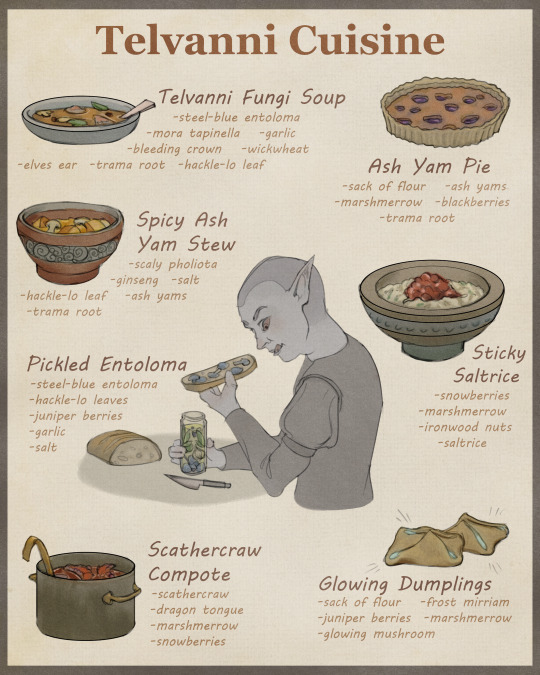
I know that nobody asked, but here's some Telvanni lore for all the foodies.
Before you begin this culinary journey, check out this post about ash yams it's essential.
-----------------------------
Telvanni Cuisine
It’s obvious that Telvanni have an extensive knowledge of fungi. After all, they live in huge mushrooms and collect and plant numerous species from all across the Tamriel to use them in their potions. It goes without saying that their cuisine is also quite fungal.
The commonfolk at Telvanni settlements as most of the Dunmer source their protein both from fungi* and insect meat. But Telvanni nobles love nurturing peculiar worldviews and traditions that differentiate them from other races - or even other Dunmer. One of them is their distaste for anything that doesn’t grow in soil. They frown upon hunter traditions of Ashlanders and stock-raising of house Redoran and regard them as “primitive” in contrast to the delicate art of growing fungi.
The alchemy ingredients are an obvious exception from this rule, but in general as their occupations don’t usually include menial work, their light and low-calorie cuisine perfectly matches their lifestyle. This resulted in traditional cuisine of the nobility being solely plant-, or more specifically, mushroom-based**, that contrasts sharply with the cuisine of Skyrim that is rich in venison and other animal-based foods***.
Noble Telvanni shun debilitating ingredients such as alcohol and moon sugar in their everyday cuisine, as keeping their minds sharp is their main priority. In order to get an indulgent sweet taste marshmerrow is used instead.
Telvanni rarely import vast quantities of vegetables from other provinces as house Hlaalu does. They use commonly grown foods like saltrice, ash yams or mushrooms as the base ingredients of the dishes. In some aspects they prefer to stick to the Dunmer traditions. The nobles, though, indulge themselves in expensive imported berries - not only because of their magic-enhancing abilities but also because of their extravagant taste.
As the Telvanni ranks feature numerous alchemists the import of alchemical ingredients is obviously very common. Telvanni chefs gradually incorporated some of the exotic spices into traditional cuisine. Especially valued are the most characterful of them that fancy up the bland taste of mushrooms, such as juniper, ginseng or garlic****.
* In real life mushrooms are a rather poor source of protein compared to legumes like beans and lentil. But since there are no legumes in TES universe (at least as far as I know) let's suppose there are some protein-rich mushrooms Telvanni can plant.
** It’s also worth mentioning that I’m a Telvanni-fixated vegan ass myself so that’s a more probable reason why I made my beloved house also vegan xD
*** A lovely example of that contrast you can encounter in @thana-topsy ‘s fanfic “Breathing Water”. This would nicely explain Neloth’s preference for apple cabbage stew.
**** This recipe for example resembles Telvanni cuisine, it was one of the inspirations from my imaginary dishes above.
Above I’ve come up with some examples of what noble Telvanni would eat on a daily basis.
Thanks for reading that and take care :3
#house telvanni#telvanni#dunmer#dark elf#dark elves#tes morrowind#tes lore#tes#tesblr#my-posts#darkelf#ash yams#morrowind
720 notes
·
View notes